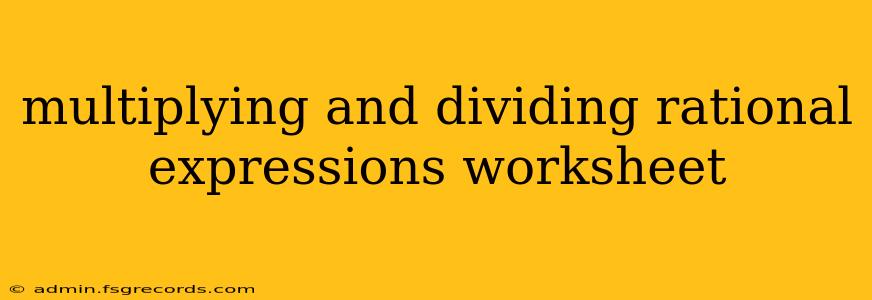This worksheet will guide you through the process of multiplying and dividing rational expressions, building your understanding from fundamental concepts to more complex scenarios. We'll break down the steps, provide examples, and offer tips to help you master this crucial algebra skill. Remember, rational expressions are simply fractions containing variables – understanding how to manipulate them is key to success in higher-level mathematics.
Understanding the Basics: Rational Expressions
Before diving into multiplication and division, let's solidify our understanding of rational expressions themselves. A rational expression is a fraction where the numerator and denominator are polynomials. For example:
- (3x² + 2x)/(x - 5) is a rational expression.
- (x + 4)/(x² - 16) is another rational expression.
Key Concepts to Remember:
- Simplification: Always simplify rational expressions before performing any operations. This involves factoring the numerator and denominator and canceling out common factors.
- Undefined Values: A rational expression is undefined when its denominator equals zero. Identify these values early to avoid errors.
Multiplying Rational Expressions
Multiplying rational expressions is similar to multiplying ordinary fractions. Here's the process:
- Factor: Factor the numerator and denominator of each rational expression completely.
- Multiply Numerators and Denominators: Multiply the numerators together and the denominators together.
- Simplify: Simplify the resulting expression by canceling out common factors in the numerator and denominator.
Example:
Multiply (x² - 4) / (x + 3) * (x + 3) / (x - 2)
- Factor: (x + 2)(x - 2) / (x + 3) * (x + 3) / (x - 2)
- Multiply: [(x + 2)(x - 2)(x + 3)] / [(x + 3)(x - 2)]
- Simplify: (x + 2) / 1 = x + 2
Dividing Rational Expressions
Dividing rational expressions involves a crucial first step: flipping (reciprocating) the second fraction and then multiplying.
- Reciprocal: Invert the second rational expression (switch the numerator and denominator).
- Multiply: Follow the multiplication steps outlined above.
Example:
Divide (x² + 5x + 6) / (x + 1) by (x + 2) / (x² - 1)
- Reciprocal: (x² + 5x + 6) / (x + 1) * (x² - 1) / (x + 2)
- Factor: [(x + 3)(x + 2)] / (x + 1) * (x + 1)(x - 1) / (x + 2)
- Multiply: [(x + 3)(x + 2)(x + 1)(x - 1)] / [(x + 1)(x + 2)]
- Simplify: (x + 3)(x - 1)
Practice Problems
Now, it's your turn! Try these problems to solidify your understanding:
- Multiply: (2x + 6) / (x² - 9) * (x - 3) / (2x)
- Divide: (x² - 4x + 3) / (x - 2) by (x - 3) / (x² - 4)
- Multiply and Simplify: (x² - 25) / (x + 5) * (x + 2) / (x -5)
(Solutions will be provided in a separate section below.)
Common Mistakes to Avoid
- Forgetting to factor completely: Incomplete factoring can lead to incorrect simplification.
- Not checking for undefined values: Always identify values of x that make the denominator zero.
- Incorrectly reciprocating when dividing: Remember to flip the second rational expression.
Solutions to Practice Problems
- 1/(x+3)
- (x-1)(x+2)
- x+2
This worksheet provides a strong foundation for multiplying and dividing rational expressions. Remember to practice regularly and consult additional resources if needed. Good luck!

